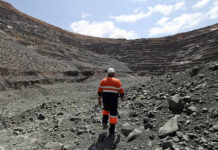
ANGOLA is making good progress on its ambition to become one of the world’s top three diamond producing nations by 2027 according to two South African diamond experts – geologist John Bristow and mining engineer Theo Botoulas.
The two – along with Derek Lahee, MD of specialist minerals processing company Consulmet – were invited by Angolan state diamond mining company Endiama to attend a Diamond Technical Workshop held recently in Luanda.
Angola’s diamond production targets were laid out by Endiama GM Pedro Galiano at the Mining Indaba conference in February 2022 and, if it all goes to plan, Botswana – currently Africa’s biggest diamond producer – may have to start looking over its shoulder.
Bristow comments Angola is going to deliver rising output from new, shallow kimberlite mines and its overall marketing drive will be helped by the “sweetener” of important high-quality alluvial production which Botswana does not have.
Bristow points out that Angolan kimberlite diamond production will be lower cost than Botswana because the new mines will be starting from surface while Debswana faces capital investment of billions of dollars to go underground at the Jwaneng mine.
He comments, “what strikes you about Angola is that there is a plan. The Angolans are really looking to improve their situation.
“There appear to be few issues around work permits. There are a lot of South African technical staff and consultants on the ground working there and the government officials dealt with are clued up and motivated.”
Botoulas adds, “Angola’s target is very achievable and I believe they could even become the world’s number one diamond producer in, say, 15 years. They have the diamond resources and they are using the latest recovery technologies
“The Endiama mining staff we interacted with were professional and experienced and they want to succeed judging by the penetrating questions they threw at us.”
The stated Angolan plan is to reach annual diamond production of 17.5 million carats by 2027 compared with 8.76 million carats in 2022.
In the past few years Angola has successfully convinced major mining groups Rio Tinto and De Beers to return to the country and the government is currently overhauling its licencing, registration and granting of mineral rights processes.
A third player in the country looking for kimberlites is Canadian-based diamond company Lipari Diamonds which has taken a 75% stake in the Tchitengo diamond project.
A major benefit to operating in Angola versus South Africa is that Angola does not have Black Economic Empowerment (BEE) with its associated spiderweb of vague regulatory requirements.
Angola is introducing a new cadastral system – the CMA (Cadastro Mineiro Digital de Angola) – which will provide an on-line platform proving real-time access to information which is something the South African government has dismally failed to achieve over the past five years.
The CMA is built on the Landfolio Cadastre System in conjunction with OceanGeo SA and Cape Town-based Spatial Dimension.
The great irony is that the driving force behind much of this is former deputy director general of South Africa’s then Department of Mineral Resources Jacinto Rocha who is now CEO of Angola’s National Agency for Mineral Resources.
Asked in 2022 how he reconciled his previous hard-line BEE stance in South Africa with his new position Rocha replied he was “just doing the job. “
“In South Africa I was implementing the BEE policy laid out by the South African government. There is no need for BEE in Angola because there was no apartheid in Angola.”
According to Bristow, the upside potential of the Angolan diamond industry lies in the development of its considerable kimberlite resources as well as recoveries from its extensive alluvial deposits.
He comments “the importance of the alluvial diamonds is that these high-quality, high value goods are sought after by diamantaires. They provide opportunities for creation of an Angolan brand and a sweetener to the country’s overall production mix and profile. “
Angola until recently had only one major kimberlite mine which was Catoca – the world’s fourth largest diamond mine – developed initially from 1998 by Russian firm Alrosa.
Bristow points out in recent years Angola state organisations – principally Endiama and the Catoca Mining Society – have quietly developed and commissioned the major Luele mine which he describes as “the largest open-pit diamond mine to begin operations anywhere in the world this decade and currently has an estimated resource of 628m carats and a projected operational lifespan of about 60 years.
Production is estimated at between 3.5m and 4m carats annually once the mine is at full commercial capacity which should happen this year.
Luele is close to Catoca and Bristow says another key component of the Angolan plan is to set up the Saurimo Diamond Hub near Catoca which will have facilities to house up to 19 cutting factories.
It will include a training school and a diamond exchange and tenants that cut and polish diamonds locally will be eligible for tax benefits and run-of-mine diamond supply.











